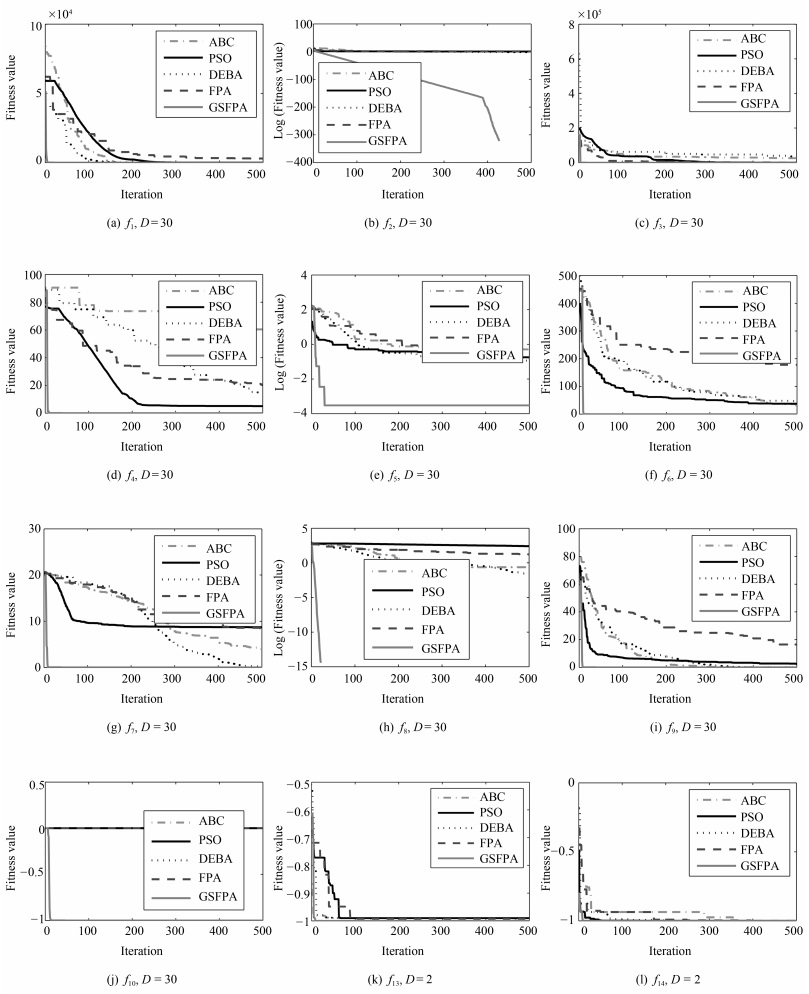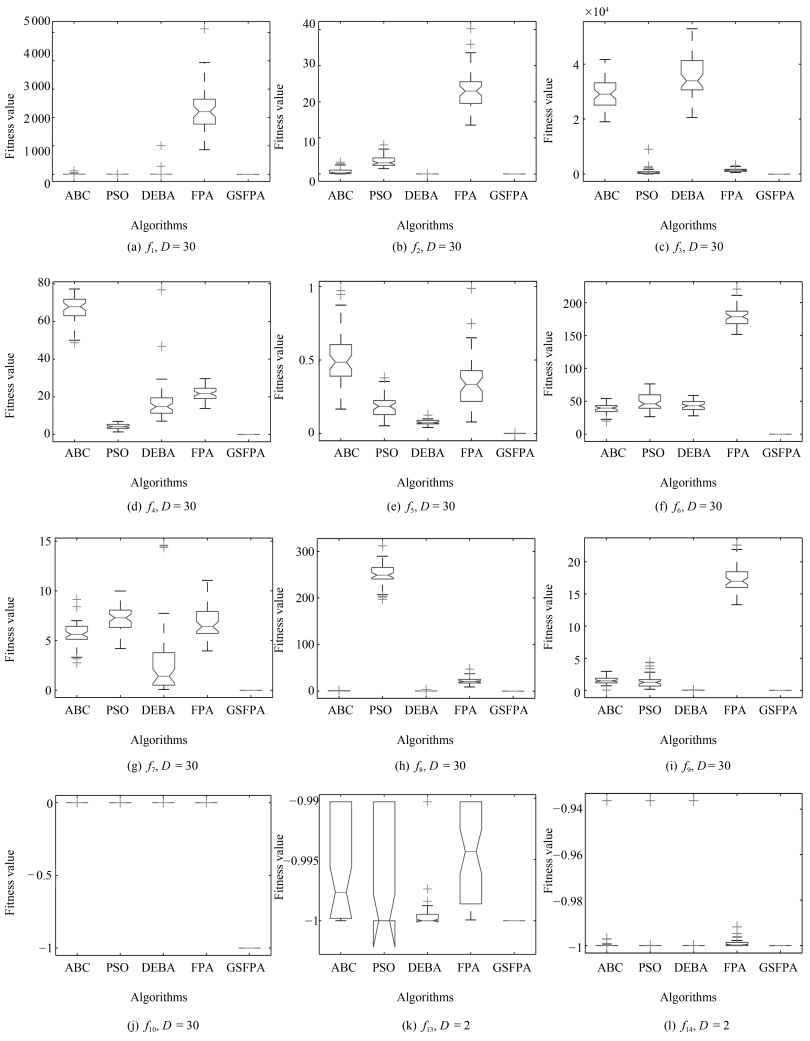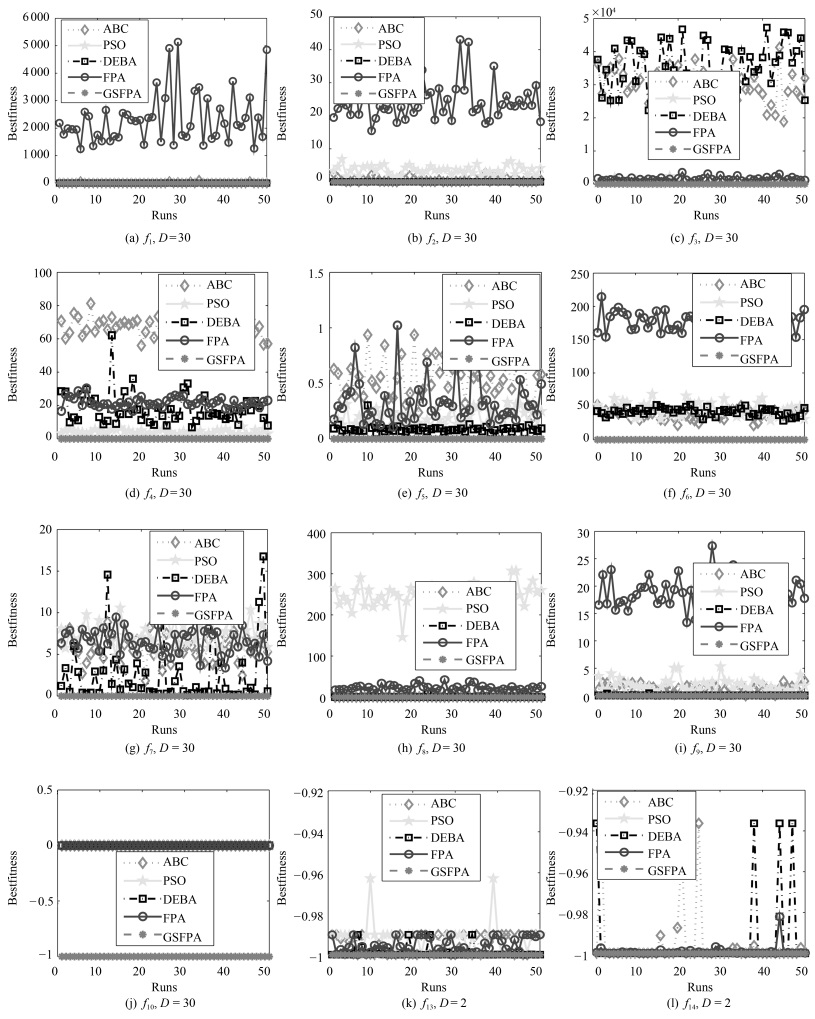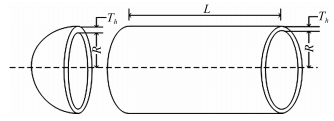-
摘要: 针对花朵授粉算法(Flower pollination algorithm,FPA)易陷入局部极值、后期收敛速度慢的不足,提出一种基于引力搜索机制的花朵授粉算法.该算法在基本花朵授粉算法的全局寻优部分,采用花朵个体间的万有引力和算法本身的莱维飞行共同实现个体位置的更新,使花朵受莱维飞行和个体间引力的双重影响,个体在通过优化信息的共享向质量大(最优位置)的个体靠近,且个体间的万有引力牵制莱维飞行的随机游走.同时又利用莱维飞行的跳跃及不均匀性步长避免个体陷入局部极值,从而提高算法的寻优能力.通过对高维单峰函数、高维多峰函数、低维函数及多峰复杂函数的优化实验结果表明,改进算法的寻优性能显著优于基本的花朵授粉算法,其收敛速度、收敛精度、鲁棒性均较对比算法有较大提升.最后,利用改进算法对弹簧张力设计问题、压力管设计问题2个工程实例进行测试,获得了较好的结果.仿真实验结果佐证了改进算法的有效性和可行性.Abstract: A flower pollination algorithm (FPA) based on gravity search mechanism is presented to overcome the problems of being easily trapped into local extremum and low speed of convergence. In the global optimization of FPA, the algorithm uses the gravity between individuals and the Lévy flight of algorithm itself to update individual locations. The flower is influenced by both gravity and Lévy flight, and individual is close to the individual which is in a higher quality (optimal position) through optimization of the information, and the random walk of Lévy flight is contained by the gravity between individuals. At the same time, the improved algorithm uses the jump and irregular step length of Lévy to limit the individual into local extremum so as to improve the algorithm's optimization ability. High dimensional unimodal function, high dimensional multimodal function, low dimensional function and multi peak complex function optimization results show that the improved algorithm has better global searching ability than the basic flower pollution algorithm, and faster convergence and more precise convergence than those of comparison algorithm. Finally, the improved algorithm is applied to two engineering examples, the tension spring design problem and the pressure vessel design problem, and obtains desired outcomes. Simulation results have proven the effectiveness and feasibility of the improved algorithm.
-
Key words:
- Flower pollination algorithm (FPA) /
- optimization ability /
- gravity /
- fitness
1) 本文责任编委 刘艳军 -
表 1 基准测试函数
Table 1 Benchmark test function
类型 测试函数 搜索空间 理论最优值 ${{f}_{1}}(x)=\sum\limits_{i=1}^{n}{x_{i}^{2}}$ [-100, 100] 0 高维 ${{f}_{2}}(x)=\sum\limits_{i=1}^{n}{\left| {{x}_{i}} \right|}+\prod\limits_{i=1}^{n}{\left| {{x}_{i}} \right|}$ [-10, 10] 0 单峰 ${{f}_{3}}(x)=\sum\limits_{i=1}^{n}{{(\sum\limits_{j-1}^{i}{{{x}_{j}}})^{2}}}$ [-100, 100] 0 函数 ${{f}_{4}}(x)={{\max }_{i}}\{\left| {{x}_{i}} \right|,1\le i\le n\}$ [-100, 100] 0 Ⅰ ${{f}_{5}}(x)=\sum\limits_{i=1}^{n}{ix_{i}^{4}}+{\rm random}[0,1)$ [-1.28, 1.28] 0 ${{f}_{6}}(x)=\sum\limits_{i=1}^{n}{[x_{i}^{2}-10\cos (2\pi {{x}_{i}})+10]}$ [-5.12, 5.12] 0 高维 ${{f}_{7}}(x)=-20\exp \left(-0.2\sqrt{\frac{1}{n}\sum\limits_{i}^{n}{x_{i}^{2}}}\right)-\exp (\frac{1}{n}\sum\limits_{i}^{n}{\cos (2\pi {{x}_{i}}}))+20+\,{\rm e}$ [-32, 32] 0 多峰 ${{f}_{8}}(x)=1+\frac{1}{4\,000}\sum\limits_{i=1}^{n}{x_{i}^{2}}-\prod\limits_{i=1}^{n}{\cos (\frac{{{x}_{i}}}{\sqrt{i}})}$ [-600, 600] 0 函数 ${{f}_{9}}(x)=\sum\limits_{i=1}^{n}{\left| {{x}_{i}}\sin ({{x}_{i}})+0.1{{x}_{i}} \right|}$ [-10, 10] 0 Ⅱ ${{f}_{10}}(x)=\left\{ \left[ \sum\limits_{i=1}^{n}{{{\sin }^{2}}({{x}_{i}})} \right]-\exp (-\sum\limits_{i=1}^{n}{x_{i}^{2}}) \right\} \exp \left[ -\sum\limits_{i=1}^{n}{{{\sin }^{2}}\sqrt{\left| {{x}_{i}} \right|}} \right]$ [-10, 10] -1 ${{f}_{11}}(x)=\frac{\pi }{D}{{\{10\sin (\pi {{y}_{1}})+ \sum\limits_{i=1}^{D-1}{({{y}_{i}}}-1)}^{2}}[1+10{{\sin }^{2}}(\pi {{y}_{i+1}})]+{{({{y}_{n}}-1)}^{2}}\}+\\ \;\;\;\;\;\;\; \sum\limits_{i=1}^{n}{u({{x}_{i}}},10,100,4)$ ${y_i} = 1 + \frac{{{x_i} + 1}}{4},u({x_i},a,k,m) = \left\{ \begin{array}{l} k{({x_i} - a)^m}{x_i} > a\\ 0 - a < {x_i} < a\\ k{( - {x_i} - a)^m}{x_i} < a \end{array} \right.$ [-50, 50] 0 ${{f}_{12}}(x)=0.1\{{\sin}^{2}(3\pi {{x}_{1}})+\sum\limits_{j=1}^{n-1}({x}_{i}-1)^{2} [1+10{{\sin}^{2}}(\pi {{x}_{i+1}})]+\\ \;\;\;\;\;\; {{({{x}_{n}}-1)}^{2}}[1+{{\sin}^{2}}(2\pi {{x}_{n}})]\}+ \sum\limits_{i=1}^{n}{u({{x}_{i}},5,100,4)}$ [-50, 50] 0 低维 ${{f}_{13}}(x)=\dfrac{{{\sin }^{2}}\sqrt{{{x}_{1}}^{2}+{{x}_{2}}^{2}}-0.5}{{{[1+0.001({{x}_{1}}^{2}+{{x}_{2}}^{2})]}^{2}}}-0.5$ [-100, 100] -1 函数 ${{f}_{14}}(x)=-\dfrac{1+\cos (12\sqrt{x_{1}^{2}+x_{2}^{2}})}{0.5(x_{1}^{2}+x_{2}^{2})+2}$ [-5.12, 5.12] -1 Ⅲ ${{f}_{15}}(x)=100{{(x_{1}^{2}-{{x}_{2}})}^{2}}+{{(1-{{x}_{1}})}^{2}}$ [-2.048, 2.048] 0 ${{f}_{16}}(x)=4{{x}_{1}}^{2}-2.1{{x}_{1}}^{4}+({{x}_{1}}^{6})/3+{{x}_{1}}{{x}_{2}}-4{{x}_{2}}^{2}+4{{x}_{2}}^{4}$ [-5, 5] -1.0316 表 2 高维单峰测试函数的寻优性能比较
Table 2 Comparison of optimization performance of high dimensional single peak test function
函数 维数 算法 最优值 优化均值 最差值 标准方差 寻优成功率 (%) ABC 9.2427E-05 4.8174 66.7505 14.1214 24 PSO 0.1180 0.2232 0.3785 0.0605 0 ${{f}_{1}}$ 30 DEBA 5.2325E-04 0.0014 0.0028 5.4156E-04 18 FPA 1.1778E+03 2.2957E+03 3.4901E+03 646.8865 0 GSFPA 0 0 0 0 100 ABC 0.0152 0.6900 2.5079 0.8117 0 PSO 1.4780 3.3433 9.5861 1.6890 0 ${{f}_{2}}$ 30 DEBA 0.0025 0.0052 0.0106 0.0015 0 FPA 13.5573 23.4681 36.6924 5.3017 0 GSFPA 0 0 0 0 100 ABC 1.6156E+04 3.0746E+04 4.1250E+04 5.3292E+03 0 PSO 88.8952 683.7598 4.8081E+03 936.5027 0 ${{f}_{3}}$ 30 DEBA 2.2154E+04 3.4653E+04 4.8471E+04 7.6307E+03 0 FPA 584.5559 1.3876E+03 2.6430E+03 538.4057 0 GSFA 0 0 0 0 100 ABC 47.6764 65.2530 78.1880 7.0160 0 PSO 1.0993 4.1731 9.0819 1.4612 0 ${{f}_{4}}$ 30 DEBA 8.1257 15.6942 81.0078 10.8027 0 FPA 13.9639 20.7465 29.1326 3.4006 0 GSFPA 0 0 0 0 100 ABC 0.1712 0.4903 0.8525 0.1273 0 PSO 0.0637 0.1832 0.3938 0.0746 0 ${{f}_{5}}$ 30 DEBA 0.0433 0.0828 0.1603 0.0213 0 FPA 0.1585 0.3661 1.0155 0.1922 0 GSFPA 2.2586E-06 1.8984E-04 7.0389E-04 1.5126E-04 100 表 3 高维多峰测试函数的寻优性能比较
Table 3 Comparison of optimization performance of high dimensional multi peak test function
函数 维数 算法 最优值 优化均值 最差值 标准方差 寻优成功率 (%) ABC 6.6684 39.1469 60.9988 8.2963 0 PSO 27.3446 47.8415 70.8488 11.7886 0 ${{f}_{6}}$ 30 DEBA 34.7258 42.5556 55.3031 5.0813 0 FPA 143.1259 175.2331 216.0925 16.1655 0 GSFPA 0 0 0 0 100 ABC 3.2920 5.6133 7.9734 1.1488 0 PSO 4.3528 7.3247 10.4073 1.4364 0 ${{f}_{7}}$ 30 DEBA 0.1303 3.5707 16.8599 4.3272 0 FPA 3.8093 7.2448 11.4055 1.6964 0 GSFPA 8.8818E-16 8.8818E-16 8.8818E-16 0 100 ABC 0.0356 0.4391 2.2319 0.5126 0 PSO 187.3601 254.1564 330.4583 24.6100 0 ${{f}_{8}}$ 30 DEBA 0.0011 0.0113 0.0338 0.0075 0 FPA 9.0459 19.8711 34.9888 5.8755 0 GSFA 0 0 0 0 100 ABC 0.0561 1.3706 2.7080 0.6986 0 PSO 0.1329 1.7424 5.6551 1.1923 0 ${{f}_{9}}$ 30 DEBA 0.0139 0.0263 0.0761 0.0105 0 FPA 11.6981 18.6693 24.3616 2.6186 0 GSFPA 0 0 0 0 100 ABC 2.1281E-13 3.3409E-13 4.4923E-13 6.2213E-14 0 PSO 1.1895E-14 2.6204E-14 9.4151E-14 1.2864E-14 0 ${{f}_{10}}$ 30 DEBA 9.0212E-12 1.1764E-09 1.3729E-08 2.2561E-09 0 FPA 4.9276E-11 3.9801E-10 1.4113E-09 2.7759E-10 0 GSFPA -1 -1 -1 0 100 ABC 1.6714E-05 0.3305 1.7371 0.5093 46 PSO 1.4931 4.0850 6.7058 1.1217 0 ${{f}_{11}}$ 30 DEBA 0.0131 0.1532 0.7424 0.1544 0 FPA 17.0920 1.2323E+04 1.0090E+05 2.4877E+04 0 GSFPA 0.5621 1.0204 1.6052 0.2623 0 ABC 3.1508E-05 0.7497 4.8903 1.4447 32 PSO 0.1163 16.4369 44.1686 12.3563 0 ${{f}_{12}}$ 30 DEBA 0.1822 0.5158 2.5593 0.3937 0 FPA 2.2491E+04 6.8604E+05 3.5217E+06 6.9315E+05 0 GSFPA 2.9911 2.9964 2.9998 0.0024 0 表 4 低维多峰测试函数的寻优性能比较
Table 4 Comparison of optimization performance of low dimensional multi peak test function
函数 维数 算法 最优值 优化均值 最差值 标准方差 寻优成功率 (%) ABC -0.999999999999991 -0.9947280936 -0.9902752472 0.0046 26 PSO -0.999999985912173 -0.9909729558 -0.8217776974 0.0270 54 ${{f}_{13}}$ 2 DEBA -1 -0.9902840887 -0.9902839963 0.0041 86 FPA -0.9902840887 -0.9902840887 -0.9902840887 0.0038 0 GSFPA -1 -1 -1 0 100 ABC -1 -0.9958895987 -0.9362452095 0.0133 70 PSO -0.999999996387299 -0.9987217811 -0.9362453268 0.0090 98 ${{f}_{14}}$ 2 DEBA -1 -0.9999933301 -0.9996665051 4.7163E-05 100 FPA -0.9999993778 -0.9992595211 -0.9884197110 1.8405E-03 84 GSFPA -1 -1 -1 0 100 ABC 3.2521E-05 0.0213 0.2329 0.0401 22 PSO 5.2032E-08 7.7110E-06 7.0335E-05 1.3433E-05 100 ${{f}_{15}}$ 2 DEBA 6.0310E-122 0.0049894963 0.2494748168 0.0352810669 98 FPA 4.4709E-14 1.2759E-08 5.0346E-07 7.1014E-08 100 GSFA 0 0 0 0 100 ABC -1.0316284535 -1.0316284534 -1.0316284535 4.6186E-16 100 PSO -1.0316284501 -1.0316279534 -1.0316207215 1.3119E-06 100 ${{f}_{16}}$ 2 DEBA -1.0316284535 -1.0316284535 -1.0316284535 2.3738E-16 100 FPA -1.0316284528 -1.0316283539 -1.0316276702 1.4887E-07 100 GSFPA -1.031628172 -1.0316011959 -1.0315001067 3.0222E-05 92 表 5 多峰函数在不同高维上的优化均值比较
Table 5 Comparison of optimal mean for multi peak functions on different high dimensions
维数 函数 算法 50 100 150 200 250 300 平均变化率 (%) ${{f}_{6}}$ FPA 3.48071E+02 8.1029E+02 1.2901E+03 1.7671E+03 2.2710E+03 2.7899E+03 0.5607 GSFPA 0 0 0 0 0 0 0 ${{f}_{7}}$ FPA 6.8115 7.8408 8.1632 8.4016 8.1426 8.0703 0.0363 GSFPA 8.8818E-16 8.8818E-16 8.8818E-16 8.8818E-16 8.8818E-16 8.8818E-16 0 ${{f}_{8}}$ FPA 4.7387E+01 1.3265E+02 1.905E+02 2.6661E+02 3.4341E+02 4.1927E+02 0.6231 GSFPA 0 0 0 0 0 0 0 表 6 7种群智能算法对基准函数的优化性能比较
Table 6 Comparison of optimization performance of the 7 swarm intelligence algorithms on the benchmark functions
函数 PSO-RM FETLBO PSO_CG DMPSO MEABC DDIFPA GSFPA ${{f}_{1}}$ Mean 0 3.43E-231 0 2.602520E-133 4.85E-40 4.62E-289 0 Std.Dve 0 3.21E-231 - 1.389667E-132 2.31E-40 0 0 ${{f}_{2}}$ Mean 0 4.16E-116 - 6.434905E-11 1.25E-21 0 2.8396E-223 Std.Dve 0 1.07E-115 - 1.771972E-10 3.56E-21 0 0 ${{f}_{3}}$ Mean 0 0 2.6132E-07 3.240222E-59 9.81E+03 4.44E-15 0 Std.Dve 0 0 - 2.268155E-58 2.49E+03 0 0 ${{f}_{5}}$ Mean - - - - 2.29E-02 3.7294E-03 9.1393E-04 Std.Dve - - - - 1.38E-02 9.9611E-04 7.4609E-04 ${{f}_{6}}$ Mean 3.22E-14 - 19.6502 3.979836 0 0 0 Std.Dve 8.66E-14 - - 13.49628 0 0 0 ${{f}_{7}}$ Mean 1.13E-14 4.44E-15 0.1737 1.140421E-14 2.90E-14 4.44E-15 8.8818E-16 Std.Dve 9.12E-15 0 - 8.672115E-15 1.32E-14 0 0 ${{f}_{8}}$ Mean 0.0094 0 4.7268E-13 3.774758E-17 0 0 0 Std.Dve 0.0096 0 - 9.049510E-17 0 0 0 ${{f}_{11}}$ Mean - - - - 3.02E-17 1.57E-32 1.2855 Std.Dve - - - - 0 2.89E-48 0.0574 表 7 5种群智能算法对复合基准函数的寻优性能对比
Table 7 Comparison of optimization performance of the 5 swarm intelligence algorithms on the composite benchmark function
函数 算法 平均值 标准差 最优值 最差值 Wilcoxon ABC 1.29E+02 8.86E+01 5.22E-01 2.25E+02 + ASFA 4.80E+02 1.15E+02 2.99E+02 6.69E+02 + CF1 PSO 2.00E+02 1.05E+02 1.53E-01 3.00E+02 + FPA 1.98E+02 7.44E+01 1.06E+02 3.12E+02 + GSFPA 1.28E+02 3.50E+01 3.80E+01 1.86E+02 ABC 1.49E+02 4.94E+01 7.78E+01 2.26E+02 + ASFA 5.49E+02 1.08E+02 4.03E+02 7.19E+02 + CF2 PSO 1.76E+02 8.59E+01 1.02E+02 3.89E+02 + FPA 2.27E+02 1.82E+02 5.78E+01 6.40E+02 + GSFPA 1.19E+02 5.26E+01 7.42E+01 2.36E+02 ABC 2.90E+02 7.53E+01 1.51E+02 4.03E+02 - ASFA 1.03E+03 1.39E+02 8.18E+02 1.24E+03 + CF3 PSO 6.27E+02 2.32E+02 2.69E+02 9.02E+02 $\approx$ FPA 4.81E+02 9.02E+01 3.00E+02 5.80E+02 + GSFPA 4.35E+02 6.10E+01 3.29E+02 5.28E+02 ABC 4.98E+02 9.10E+01 3.93E+02 6.26E+02 + ASFA 9.99E+02 9.35E+01 8.41E+02 1.14E+03 + CF4 PSO 5.67E+02 7.01E+01 4.18E+02 6.50E+02 $\approx$ FPA 5.27E+02 1.63E+02 3.72E+02 7.76E+02 + GSFPA 4.95E+02 3.58E+01 4.41E+02 5.67E+02 ABC 1.20E+02 1.19E+02 4.38E+01 4.13E+02 - ASFA 5.56E+02 2.12E+02 1.95E+02 9.74E+02 + CF5 PSO 1.75E+02 1.78E+02 4.18E+00 5.04E+02 + FPA 1.90E+02 1.03E+02 4.89E+01 3.81E+02 + GSFPA 1.29E+02 6.19E+01 6.80E+01 2.61E+02 ABC 7.80E+02 1.82E+02 5.11E+02 9.07E+02 + ASFA 9.25E+02 2.11E+01 9.03E+02 9.65E+02 + CF6 PSO 9.02E+02 8.42E-01 9.00E+02 9.03E+02 + FPA 7.30E+02 1.76E+02 4.66E+02 9.07E+02 + GSFPA 6.63E+02 1.64E+02 5.26+02 9.06E+02 表 8 6种不同算法求解弹簧张力设计问题的最优解比较
Table 8 Comparison of the optimal solution for the spring tension design problem by 6 different algorithms
算法 x1(d) x2(D) x3(P) f(x) CDE 0.051609 0.354714 11.410831 0.126702 HPSO 0.051706 0.357126 11.265083 0.0126652 AATM 0.051813 0.359690 11.119252 0.0126682 SCA 0.052160 0.368158 10.648442 0.0126692 FPA 0.05227727802 0.3712035248 10.49087566498 0.012673971099 GSFPA 0.05141361727 0.0350365659 11.65914644838 0.012659429146 表 9 6种不同算法求解压力管设计问题的最优解对比
Table 9 Comparison of the optimal solution for the pressure vessle design problem by 6 different algorithms
算法 x1(Ts) x2(Th) x3(R) x4(L) f(x) CPSO 0.8125 0.4375 42.0913 176.7465 6 061.0777 GenAS 1.1250 0.6250 47.7000 117.7010 8 129.8000 HPSO 0.8125 0.4375 42.0984 176.6366 6 059.7143 SPA 0.8125 0.4375 40.3239 200.0000 6 288.7445 FPA 0.7956663 0.3975829 41.22425 187.8048 5 929.6933 GSFPA 0.7862954 0.3924454 40.72142 194.6374 5 916.4771 -
[1] Yang X S. Flower pollination algorithm for global optimization. In:Proceedings of the 11th International Conference on Unconventional Computation and Natural Computation. Lecture Notes in Computer Science. Orléan, France:Springer, 2012. 240-249 [2] Yang X S, Karamanoglu M, He X S. Multi-objective flower algorithm for optimization. Procedia Computer Science, 2013, 18:861-868 doi: 10.1016/j.procs.2013.05.251 [3] Rodrigues D, Yang X S, de Souza A N, Papa J P. Binary flower pollination algorithm and its application to feature selection. Recent Advances in Swarm Intelligence and Evolutionary Computation. Switzerland:Springer International Publishing, 2015. 85-100 [4] Dubey H M, Pandit M, Panigrahi B K. Hybrid flower pollination algorithm with time-varying fuzzy selection mechanism for wind integrated multi-objective dynamic economic dispatch. Renewable Energy, 2015, 83:188-202 doi: 10.1016/j.renene.2015.04.034 [5] Jensi R, Jiji G W. Hybrid data clustering approach using k-means and flower pollination algorithm. Computer Science, 2015, 2(2):15-25 [6] 焦庆龙, 徐达, 李闯. 基于花朵授粉算法的产品装配序列规划. [2015-10-30]. http://www.cnki.net/kcms/detail/11.3619.TP.20151030.1647.012.htmlJiao Qing-Long, Xu Da, Li Chuang. Product assembly sequence planning based on flower pollination algorithm[EB/OL].[2015-10-30]. http://www.cnki.net/kcms/detail/11.3619.TP.20151030.1647.012.html [7] Wang R, Zhou Y Q. Flower pollination algorithm with dimension by dimension improvement. Mathematical Problems in Engineering, 2014, 2014:Article ID 481791 [8] Abdel-Raouf O, Abdel-Baset M, El-Henawy I. A new hybrid flower pollination algorithm for solving constrained global optimization problems. International Journal of Applied Operational Research, 2014, 4(2):1-13 [9] Wang R, Zhou Y Q, Qiao S L, Huang K. Flower pollination algorithm with bee pollinator for cluster analysis. Information Processing Letters, 2016, 116(1):1-14 doi: 10.1016/j.ipl.2015.08.007 [10] Draa A. On the Performances of the flower pollination algorithm-qualitative and quantitative analyses. Applied Soft Computing, 2015, 34:349-371 doi: 10.1016/j.asoc.2015.05.015 [11] Rashedi E, Nezamabadi-Pour H, Saryazdi S. GSA:a gravitational search algorithm. Information Sciences, 2009, 179(13):2232-2248 doi: 10.1016/j.ins.2009.03.004 [12] Karaboga D, Akay B. A comparative study of artificial bee colony algorithm. Applied Mathematics and Computation, 2009, 214(1):108-132 doi: 10.1016/j.amc.2009.03.090 [13] 李康顺, 潘伟丰, 汤铭端, 王峰.一种基于蜂王交配的求解复杂问题的演化算法.系统仿真学报, 2008, 20(7):1707-1712, 1757 http://www.cnki.com.cn/Article/CJFDTOTAL-XTFZ200807015.htmLi Kang-Shun, Pan Wei-Feng, Tang Ming-Duan, Wang Feng. Evolutionary algorithm for solving complex problem based on queen-bee mating. Journal of System Simulation, 2008, 20(7):1707-1712, 1757 http://www.cnki.com.cn/Article/CJFDTOTAL-XTFZ200807015.htm [14] Mirjalili S, Mirjalili S M, Lewis A. Grey wolf optimizer. Advances in Engineering Software, 2014, 69:46-61 doi: 10.1016/j.advengsoft.2013.12.007 [15] Karaboga D. An Idea Based on Honey Bee Swarm for Numerical Optimization, Technical Report-TR06, Erciyes University, Kayseri, Turkey, 2005. [16] Kennedy J, Eberhart R C. Particle swarm optimization. In:Proceedings of the 1995 IEEE International Conference on Neural Networks. Perth, Australia:IEEE, 1995. 1942-1948 [17] 肖辉辉, 段艳明.基于DE算法改进的蝙蝠算法的研究及应用.计算机仿真, 2014, 31(1):272-277, 301 http://www.cnki.com.cn/Article/CJFDTOTAL-JSJZ201401062.htmXiao Hui-Hui, Duan Yan-Ming. Research and application of improved bat algorithm based on DE algorithm. Computer Simulation, 2014, 31(1):272-277, 301 http://www.cnki.com.cn/Article/CJFDTOTAL-JSJZ201401062.htm [18] 周晓君, 阳春华, 桂卫华, 董天雪.带可变随机函数和变异算子的粒子群优化算法.自动化学报, 2014, 40(7):1339-1347 http://www.aas.net.cn/CN/abstract/abstract18405.shtmlZhou Xiao-Jun, Yang Chun-Hua, Gui Wei-Hua, Dong Tian-Xue. A Particle Swarm Optimization Algorithm with Variable Random Functions and Mutation. Acta Automatica Sinica, 2014, 40(7):1339-1347 http://www.aas.net.cn/CN/abstract/abstract18405.shtml [19] 于坤杰, 王昕, 王振雷.基于反馈的精英教学优化算法.自动化学报, 2014, 40(9):1976-1983 http://www.aas.net.cn/CN/abstract/abstract18468.shtmlYu Kun-Jie, Wang Xin, Wang Zhen-Lei. Elitist teaching-learning-based optimization algorithm based on feedback. Acta Automatica Sinica, 2014, 40(9):1976-1983 http://www.aas.net.cn/CN/abstract/abstract18468.shtml [20] 梁昔明, 李德生.嵌入共轭梯度法的混合粒子群优化算法.小型微型计算机系统, 2014, 35(4):835-839 http://www.cnki.com.cn/Article/CJFDTOTAL-XXWX201404034.htmLiang Xin-Ming, Li De-Sheng. Hybrid PSO algorithm with conjugate gradient methods. Journal of Chinese Computer Systems, 2014, 35(4):835-839 http://www.cnki.com.cn/Article/CJFDTOTAL-XXWX201404034.htm [21] 李景洋, 王勇, 李春雷.采用双模飞行的粒子群优化算法.模式识别与人工智能, 2014, 27(6):533-539 http://www.cnki.com.cn/Article/CJFDTOTAL-MSSB201406008.htmLi Jing-Yang, Wang Yong, Li Chun-Lei. Particle swarm optimization algorithm with double-flight modes. Pattern Recognition and Artificial Intelligence, 2014, 27(6):533-539 http://www.cnki.com.cn/Article/CJFDTOTAL-MSSB201406008.htm [22] Wang H, Wu Z J, Rahnamayan S, Sun H, Liu Y, Pan J S. Multi-strategy ensemble artificial bee colony algorithm. Information Sciences, 2014, 279:587-603 doi: 10.1016/j.ins.2014.04.013 [23] Liang J J, Suganthan P N, Deb K. Novel composition test functions for numerical global optimization. In:Proceedings of the 2005 IEEE Swarm Intelligence Symposium. Pasadena, CA, USA:IEEE, 2005. 68-75 [24] Suganthan P N. Benchmarks for evaluation of evolutionary algorithms[Online], available:http://www.ntu.edu.sg/home/epnsugan/index_files/SIS2005-function-codes.zip, May 6, 2014. [25] Huang F Z, Wang L, He Q. An effective co-evolutionary differential evolution for constrained optimization. Applied Mathematics and Computation, 2007, 186(1):340-356 doi: 10.1016/j.amc.2006.07.105 [26] He Q, Wang L. A hybrid particle swarm optimization with a feasibility-based rule for constrained optimization. Applied Mathematics and Computation, 2007, 186(2):1407-1422 doi: 10.1016/j.amc.2006.07.134 [27] Wang Y, Cai Z X, Zhou Y R. Accelerating adaptive trade-off model using shrinking space technique for constrained evolutionary optimization. International Journal for Numerical Methods in Engineering, 2009, 77(11):1501-1534 doi: 10.1002/nme.v77:11 [28] Ray T, Liew K M. Society and civilization:an optimization algorithm based on the simulation of social behavior. IEEE Transactions on Evolutionary Computation, 2003, 7(4):386-396 doi: 10.1109/TEVC.2003.814902 [29] He Q, Wang L. An effective co-evolutionary particle swarm optimization for constrained engineering design problems. Engineering Applications of Artificial Intelligence, 2007, 20(1):89-99 doi: 10.1016/j.engappai.2006.03.003 [30] Deb K. GeneAS:a robust optimal design technique for mechanical component design. Evolutionary Algorithms in Engineering Applications. Berlin Heidelberg:Springer, 1997. 497-514 [31] Coello C A C. Use of a self-adaptive penalty approach for engineering optimization problems. Computers in Industry, 2000, 41(2):113-127 doi: 10.1016/S0166-3615(99)00046-9 -




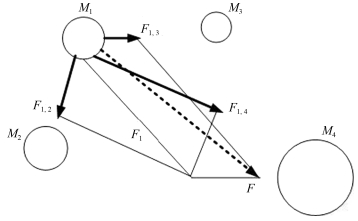
 下载:
下载:
